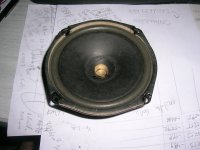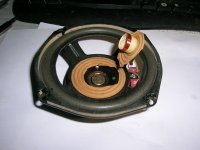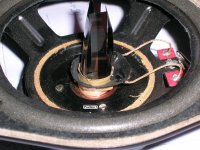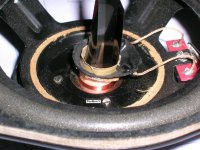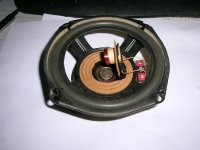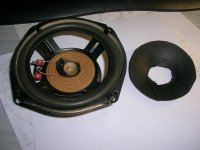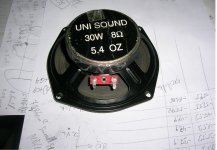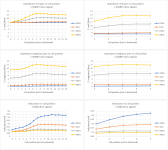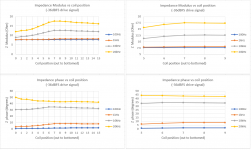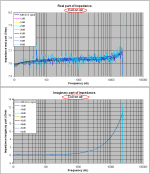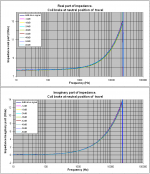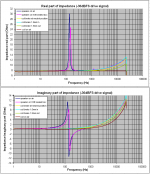Why not use Great Stuff spray foam from the local hardware store? Expands to conform. Coat the cone in mold release or use a plastic mask.
Yes - any sort of expanding PU foam spray, with a cling film cover first...
Practice on an old dead speaker first... 🙂
The foam ideas are not bad. I was thinking of making a wood ring that comes within 1/8th inch of the surface, then foaming tha edge, laying Saran Wrap gently over the foam, then gently putting it in place. Since end use requires pushing and pulling with a centering rod, I can use the centering alignment rig to hold the part against the cone until it hardens. The rig will have fiducials for x position and threaded rod. Oh, and I can use the cured surface as a mold for the ring sections I need on the back of the cone. I'm thinking up a clamping scheme to allow reaching through the basket holes to fully clamp the cone.
My plan is to put the speaker face up on a scale, setup the rig to load the cone with force, and with various x positions, read the scale. It has a zeroing function so I can read force directly.
I can also move and lock the coil in x, zero the scale, then put an amp in and record force. That will give me BLI linearity. Same procedure with inductance meter will give me Le(x) and Re(x) vs frequency.
The most technically challenging thing will be trying to graph Le(x) and Re(x) vs frequency on a 3D plot. Haven't figured how to get excel to do that yet. It doesn't help that every few days office 365 pushes "better" features for the suite, leaving me to try and figure out how to do things again.
Eddy forces I believe fight the direction of motion.so I would not expect large radial forces. If I slide a neo magnet against a copper plate, I don't notice large forces pushing the magnet normal to the surface. Just the viscous damping.
Yawn..
Maybe I should order another one just in case I do turn the test unit into an old dead one..
Jn
My plan is to put the speaker face up on a scale, setup the rig to load the cone with force, and with various x positions, read the scale. It has a zeroing function so I can read force directly.
I can also move and lock the coil in x, zero the scale, then put an amp in and record force. That will give me BLI linearity. Same procedure with inductance meter will give me Le(x) and Re(x) vs frequency.
The most technically challenging thing will be trying to graph Le(x) and Re(x) vs frequency on a 3D plot. Haven't figured how to get excel to do that yet. It doesn't help that every few days office 365 pushes "better" features for the suite, leaving me to try and figure out how to do things again.
Eddy forces I believe fight the direction of motion.so I would not expect large radial forces. If I slide a neo magnet against a copper plate, I don't notice large forces pushing the magnet normal to the surface. Just the viscous damping.
Where's your sense of danger and thrill? I plan on living on the edge, call me mister excitement...Yes - any sort of expanding PU foam spray, with a cling film cover first...
Practice on an old dead speaker first... 🙂
Yawn..
Maybe I should order another one just in case I do turn the test unit into an old dead one..
Jn
This is from some measurements on a cheap 4 inch car speaker (certainly no copper cap) a year ago.
Coil is dual layer, wire dia around 0.1mm
Coil Length: 3.5mm
Coil I. D.:15.1mm
Non conductive coil former 0.3mm thick
Front plate thickness (therefore magnetic gap length):2.8mm
Center pole extends 0.6mm above top plate.
I removed the cone and the spider, placed some 8mm film strips to hold the coil in place at various positions along the axial coil movement and beyond.
George
Coil is dual layer, wire dia around 0.1mm
Coil Length: 3.5mm
Coil I. D.:15.1mm
Non conductive coil former 0.3mm thick
Front plate thickness (therefore magnetic gap length):2.8mm
Center pole extends 0.6mm above top plate.
I removed the cone and the spider, placed some 8mm film strips to hold the coil in place at various positions along the axial coil movement and beyond.
George
Attachments
Position 0 is in free air.
Pos 1 is coil completely out of the gap, pos 15 is coil bottomed in the well.
Actual working range should be from pos 5 to pos 9, neutral is pos 7.
All impedance scans were done with M-Audio USB Audiophile card in REW, then data exported into Excel
Edit: 0dBFS corresponds to 1.286Vrms
George
Pos 1 is coil completely out of the gap, pos 15 is coil bottomed in the well.
Actual working range should be from pos 5 to pos 9, neutral is pos 7.
All impedance scans were done with M-Audio USB Audiophile card in REW, then data exported into Excel
Edit: 0dBFS corresponds to 1.286Vrms
George
Attachments
Where's your sense of danger and thrill? I plan on living on the edge, call me mister excitement...
Well, speakers are replaceable... But that foam does stick like the proverbial. I once watched someone - despite me standing well back and calling him a total nutter - run a power drill down the clogged up nozzle of a can of PU builders foam.
The result was unsurprising - foam everywhere - including over him. Fortunately didn't go in his eyes, but he was picking it off his arms and hands for days. And as for the kitchen wall and windows.......
Well there is the experiment where you send a pulse of current through a coil around a soda can. The can gets sliced in half and the edges blown inward by the force of the eddy currents.
In the alternate case of an aluminum ring floating on a magnetic solenoid modulated by a coil at the bottom, the ring is not moving but the flux modulation is causing the ring to be repelled. It is repelled in one direction because the flux is higher on one side unlike the soda can where the axial force is small or nonexistent.
The case of the voicecoil is somewhere in between the repulsion ring and the soda can, so I think I need to add a new parameter to describe the fraction of eddy force that is axial. And maybe even modulate this parameter as the coil translates through the motor geometry.
If this is true it's interesting to note that there may be radial expanding forces on the voicecoil with strength in the same ballpark as the cone force.
This makes me think back to the guys winding voicecoils inside the former rather than outside. If the eddy forces are significant then this may reduce delamination of the windings at higher powers.
In the alternate case of an aluminum ring floating on a magnetic solenoid modulated by a coil at the bottom, the ring is not moving but the flux modulation is causing the ring to be repelled. It is repelled in one direction because the flux is higher on one side unlike the soda can where the axial force is small or nonexistent.
The case of the voicecoil is somewhere in between the repulsion ring and the soda can, so I think I need to add a new parameter to describe the fraction of eddy force that is axial. And maybe even modulate this parameter as the coil translates through the motor geometry.
If this is true it's interesting to note that there may be radial expanding forces on the voicecoil with strength in the same ballpark as the cone force.
This makes me think back to the guys winding voicecoils inside the former rather than outside. If the eddy forces are significant then this may reduce delamination of the windings at higher powers.
It would seem that there are many here who would like to talk about 'amateur' physics experiments with loudspeakers than I would. But there is still progress in audio electronics design, and vinyl records have now made a significant comeback! In fact, new phono stages at all price ranges are being made just about everywhere, and they are mostly better than what is discussed here on this website.
Starting with a '$100' phono stage, designed by a former DIY contributor, through iFi, direct from China soon. Then we go through the whole range of price points through $11,500 for my latest effort through Audible Illusions, and then up again to $80,000+ for the very best, including some of my own, like Constellation and others, especially tube products. Yes, phono is very much alive in some circles. It can be an expensive hobby however, unless you like to look in Goodwill record bins, etc.
What this says is that phono has some qualities that are difficult to duplicate by digital, although the very best digital seems to get there, or at least close. So far, I can just tolerate CD, but 24-96 and SACD is very good. I do have to put up with some ticks and pops, but better phono stages, etc can be quiet enough to be below normal room ambient, and ultrasonic record cleaning machines are the rage! They really do bring back used vinyl records, amazingly, sometimes. CD, used, today is cheap too! But I can just barely tolerate it, myself.
I realize that this is now an IC world, but there are still those who want better.
Starting with a '$100' phono stage, designed by a former DIY contributor, through iFi, direct from China soon. Then we go through the whole range of price points through $11,500 for my latest effort through Audible Illusions, and then up again to $80,000+ for the very best, including some of my own, like Constellation and others, especially tube products. Yes, phono is very much alive in some circles. It can be an expensive hobby however, unless you like to look in Goodwill record bins, etc.
What this says is that phono has some qualities that are difficult to duplicate by digital, although the very best digital seems to get there, or at least close. So far, I can just tolerate CD, but 24-96 and SACD is very good. I do have to put up with some ticks and pops, but better phono stages, etc can be quiet enough to be below normal room ambient, and ultrasonic record cleaning machines are the rage! They really do bring back used vinyl records, amazingly, sometimes. CD, used, today is cheap too! But I can just barely tolerate it, myself.
I realize that this is now an IC world, but there are still those who want better.
Last edited:
If you choose to define "amateur" as anything you don't understand, then yah, it's amateur.It would seem that there are many here who would like to talk about 'amateur' physics experiments with loudspeakers than I would.
However, Some of what is being discussed here is beyond SOTA. Try as I might, I cannot find anybody who has done the tests I am working on. Others have done great stuff, but my focus is on the esoteric effects others did not look for.
Since my job for the last 25 years has been magnets, magnetic fields, and the measurement of.. at levels significantly beyond your understanding, I have huge expertise in measurement of such. What I see in your audio world is quite behind SOTA in my world.
That said, the efforts and discussions I have had the pleasure of engaging in with those here (with the exception of you of course, all you do is deflect and denigrate) are just fantastic.
Honestly, I would love for you to engage the discussion instead of your typical "nobody knows anything but me" schtick.
But even if you don't engage, the discussion will move forward without you. I would rather you be a part of it.
HEY!!! Your in the Berkeley area, no? I may have to go to LBNL in the next few weeks, consult on their machine being built. If so, maybe we could meet somewhere, you could slap my face in person...over dinner and drinks of course.😉
Jn
Last edited:
...So far, I can just tolerate CD, but 24-96 and SACD is very good.
You would probably like what we can do now with a well recorded CD. It it can sound better than you have probably ever heard from any digital audio, including the two you describe as very good.
If so, maybe we could meet somewhere, you could slap my face in person...over dinner and drinks of course.😉
Jn
😀😀😀😀 That's funny.
Who pays for dinner... that could also be another slap in the face if not used to bay-area prices.
-Richard
Richard, I do want to say that I think that your early idea of adding just one power resistor to a amp channel to get a noticeable reduction in distortion is truly elegant, and I don't claim that very often. The idea of changing the effective source impedance has been known, but your approach is both efficient and relatively simple to implement.
Other approaches discussed here seem impractical.
Other approaches discussed here seem impractical.
Hey, I offered. Oh well.😀😀😀😀 That's funny.
Who pays for dinner... that could also be another slap in the face if not used to bay-area prices.
-Richard
Showing them how to design a big scientific machine wiring to code isn't a walk in the park. Everybody tends to design the cable tray system to give 25 to 50% fill margin based on what they think they will have in terms of cable loading. And when it's time to pull cables, they find out all the ones they missed. And run out of cable tray.
I designed for 50% fill based on what I could glean from the machine design prints. And then I added in an additional 50% tray capability which to date has not been required. So far, we've not reached 75% fill.
Jn
....efficient and relatively simple to implement.
Simple and efficient are always the holy grail..
Current drive seems impractical for various reasons, resonance and runaway to name a few concerns of mine.Other approaches discussed here seem impractical.
The Jn drive requires a second coil set, a second set of wires, and a specific amp topology, which is neither simple, nor practical w/r to the driver. As a possible take over the planet scenario, it certainly is not.
However, as a diy, certainly possible for many to implement. As a diagnostic tool for learning what is misunderstood in current driver technology and understandings, it's a gold mine.
But only if you take the effort to understand. A hybrid design which is Vdrive LF and Idrive mid and hf might help existing drivers. My work is to better the drivers.
Jn
I don't know..... I can't believe anything has improved beyond where things were when I gave up on vinyl/LP as a source. Records are still made same way, so there is no improvement from the LP as a music signal source. Distortion which measurably increases with each playing, wear on the LP and needle replacements and list is endless.john curl;5909067 said:But there is still progress in audio electronics design, and vinyl records have now made a significant comeback!
What this says is that phono has some qualities that are difficult to duplicate by digital, although the very best digital seems to get there, or at least close. So far, I can just tolerate CD, but 24-96 and SACD is very good. I do have to put up with some ticks and pops, but better phono stages, etc can be quiet enough to be below normal room ambient, and ultrasonic record cleaning machines are the rage! They really do bring back used vinyl records, amazingly, sometimes.
It may be possible to have wider BW and faster transient time than CD. CD is all but a legacy item also. 24/96 and beyond out perform both now. And that is getting better DAC etc as time goes on.
noTHx-
-Richard
Last edited:
One power resistor added to amp channel changes frequency response as a main effect, so it sounds "different". Similar to tube amplifier. A small change in speaker nonlinear distortion is unimportant and probably inaudible, contrary to freq response change which is audible. It is the speaker directivity to be improved, not the distortion, which is of secondary importance.
It is the speaker directivity to be improved, not the distortion, which is of secondary importance.
+1
//
jneutron, would any of the eddy forces look like this? Red trace is the coil velocity, yellow trace is the force from the eddy current.
Looks reasonable. You need to show the current as well, so it is obvious that velocity times current is the stimulus.
Jn
Richard's article showed reduction of acoustic distortion from 5% to 2.6% near resonance. My "bad" simulation predicts reduction of current distortion from 0.256% to 0.199% at 1kHz. Your frequency response issue seems rather easy to address, we have tools like Rephase and equalizer but very few selection to reduce distortion. What have you to offer to minimize acoustic distortion? Or are you saying we all should simply accept and do nothing for the high acoustic distortion? I thought we all want somewhat better fidelity.One power resistor added to amp channel changes frequency response as a main effect, so it sounds "different". Similar to tube amplifier. A small change in speaker nonlinear distortion is unimportant and probably inaudible, contrary to freq response change which is audible. ...
Rather extraordinary claim don't you think? They say no improvement can be made without the ability to measure.... not the distortion, which is of secondary importance.
Last edited:
In that case the 3rd harmonic was achieved by making the eddy current path length a function of velocity. I can't generate 3rd harmonics using velocity times current. It needs 3 multiplications. Hence F=B*L(v)*i leads to a third harmonic. But if L is not a function of velocity then I don't know how to get 3rd harmonics.
Here is it without all that just showing the force applied when the current and velocity are in phase. There is a DC component to the force. Red is current, orange is velocity and yellow is force.
Here is it without all that just showing the force applied when the current and velocity are in phase. There is a DC component to the force. Red is current, orange is velocity and yellow is force.
Attachments
- Status
- Not open for further replies.
- Home
- Member Areas
- The Lounge
- John Curl's Blowtorch preamplifier part III
